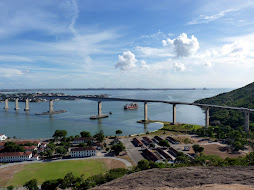Saturday, July 24, 2010
Subscribe to:
Comments (Atom)
Fotos de Navios que tocam nosso porto! Photos of ships traffic in the vitória harbor
The city has two ports: the Port of Vitória and the Port of Tubarão.
The Port of Vitória is the most difficult port for ships to access in all of Brazil. The Bay of Vitória is extremely narrow, with stones and mountains that complicate the access by freighters and maritime cruisers to the docks. Ships, cars, and people all compete for space. There are restrictions on traffic, limiting the use of the port. Today the port is mostly used by cruise ships and for the repair of ships and oil platforms.
The Port of Tubarão was designed in the 1960s by Companhia Vale do Rio Doce when the Port of Vitória began showing signs of saturation. It has far easier access to the sea. From its opening in 1966, its capacity has gradually increased, reaching 80 million tonnes/year in the last decade. Although originally created to export iron ore, in recent years it has added silos for storing grains and soybean meal. The port is located at one end of Camburi Beach.
The City of Vitoria (Portuguese), blessed with three ports, was an important center for imports to the rest of the state. It also exports agricultural and industrial products, performing a vital function for the State of Espirito Santo. While its role as marketplace and coffee port built the city in the early 20th Century, its economy has diversified. Today, it is home to a productive iron processing and steel-making industry. With the recent discovery of oil in the state, the Port of Vitoria has found additional revenues that support a growing tourism industry and real estate market. The Port of Vitoria is famous for its beaches and culture. It has abundant parks and forests, and cultural events enliven the tranquil setting.
In the 1960s, Port of Vitoria facilities were overwhelmed. The Port of Tubarao was opened in 1966. With much easier ocean-going access, it is located at the north end of Camburi Beach on the open waters of Espirito Santo Bay. While it was created to handle iron ore, over the years, traffic has increased to include grains and soybean meal as well. The Port of Praia Mole was built in the 1980s to handle the ever-increasing traffic through the Port of Vitoria. Together, the three ports are part of the Port of Vitoria’s Espirito Santo Complex.
Today, the complex is one of Brazil’s most important ports. It is connected by rail and highway to the hinterlands and offers a capable inter-modal transportation system. The federal government’s Companhia Docas do Espirito Santo (CODESA) manages and maintains port facilities that include the following.
The Port of Vitoria has modern infrastructure operated by public-private partnerships that include over 60 maritime agencies, more than 40 port operators, and more than 10 cargo terminals that serve over 2000 ships every year.
Capuaba Quay is 774 meters long with alongside depth of almost 11 meters. It contains eight thousand square meters of warehouse space, 100 thousand square meters of open yards, and a retro-port of about 300 thousand square meters. Paul Quay is 420 meters long with alongside depth of almost 10 meters and contains 25 thousand square meters of yards.
The liquid bulk terminals handle petroleum products and alcohol at a wharf of 162 meters with alongside depth of 8.23 meters. The dock has capacity to handle 500 cubic meters per hour and to store up to 50 thousand cubic meters. The Paul Quay at the Port of Vitoria handles solid bulk, primarily iron ore. It rail access and two wharves of 420 meters with alongside depth of 10.7 meters.
The CPVV Terminal serves the oil extraction and refining industry ( Oil industry ) and handles general and containerized cargo. It can accommodate ships of 250 meters with a draft of 10.5 meters. The Victory Quay handles general cargo, primarily paper, cellulose, sugar, grains, and iron products with four berths at total length of 766 meters and alongside depth from 9 to 10.5 meters. Praia Mole is a private quay for handling Steel products and mineral coal.


















